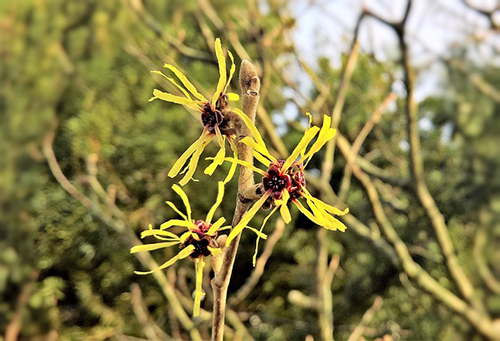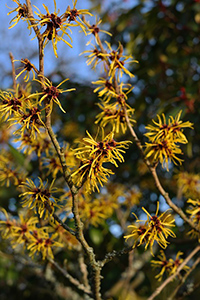Contents
The fruits of the witch hazel plant are woody capsules similar to hazelnuts, and when ripe, they explode noisily. Because of this, North American Indians believed that this tree was bewitched. Today, witch hazel is one of the most effective plants for fighting circulatory disorders.

Witch Hazel Plant Scientific Facts
- Other names: Hazelnut, pistachio, snapping hazel, spotted alder, stripped alder, tobacco wood, winterbloom.
- French: Hamamelis.
- Spanish: Hamamelis, avellano de bruja
- Environment: The witch hazel plant is native to the West Coast of the United States and Canada; it is grown in Europe as an ornamental plant.
- Description: This tree of the Hamamelidaceae family grows up to five meters high. It has alternate, oval-shaped leaves and yellow flowers with four tongue-shaped petals.
- Parts of the plant used medicinally: The leaves and the bark.
Healing Properties and Uses

The leaves and bark of this plant contain several types of tannins, among which the most outstanding are hamamelitannins, flavonoids, and saponins. It has the following properties:
- Venotonic. It contracts the wall of veins, activating the blood flowing internally. Thus, it benefits varicose veins, phlebitis, swollen legs, and hemorrhoids.
- Hemostatic (stops bleeding). It strengthens the walls of veins and blood capillaries, similar to that of vitamin P (rhutine). It is employed in menopausal disorders and metrorrhagia (uterine hemorrhages).
- Witch hazel for skin disorders. It activates blood flow in the skin and has cicatrizant and astringent effects. It is employed against dermatitis, eczema, dry skin, and wrinkles. It is a component of many beauty products.
- Eye sedative. Witch hazel infusion or distilled water (pharmaceutical preparation) is used as eyedrops to wash and relax the eyes. They fight conjunctivitis caused by dust, smoke, pollution, and the irritant action of swimming pools or seawater. These eye drops are also helpful to alleviate eye tiredness caused by any activity demanding great visual attention, such as driving or working with computers (because of their screens).
This plant is a fantastic herb and among the best remedies for stopping excessive menstruation and bleeding from the lungs, uterus, stomach, and bowels. The plant’s inner bark possesses hemostatic and soothing properties, which gives witch hazel its hemorrhage-stopping abilities. The plant can also treat uterine problems, varicose veins, prolapsed bowel, leukorrhea, hemorrhoids, diphtheria, and diarrhea. It can also be helpful as a vaginal douche.
The herb is used explicitly for bleeding wounds, minor burns, varicose veins, and insect bites in external applications. It is also used for tonsilitis, sore muscles, sore breasts, poison ivy, and bruises. The inner bark can be used to make a poultice that is beneficial to treat eye inflammation, varicose veins, and hemorrhoids.
Witch hazel can be employed as an injection for infections, vaginal discharges, and bleeding piles. As a poultice or fomentation, it is suitable for sore and inflamed eyes, oozing skin disease, and bed sores. In addition, it is beneficial for almost any external and internal condition. When combined with a small amount of peppermint oil, the herb can be used as a mouthwash for inflamed gums and sore throat.
A tea made from the plant’s twig can be rubbed on an athlete’s legs, keeping them limber and relieving lameness. Witch hazel tea can be beneficial for asthma, cough, cholera, and bloody dysentery. Astringent bark tea can be helpful for lung ailments and is used externally for sore muscles and bruises. The herb is widely used in eyewashes, ointments, and distilled extracts as an astringent for eye conditions, profuse menstrual flow, and suppressing and toning skin and piles.
Witch hazel is also commercially used to treat itching, minor aches and pains, irritation, and hemorrhoids. The plant’s bark and leaves contain tannins (hamamelitannin and proanthocyanidins), which are believed to be responsible for their hemostatic, astringent, and antioxidant properties.
In the United States, the plant has been approved as a nonprescription product and as an external anorectal mainly used to relieve symptoms caused by hemorrhoids, itching, irritation, and minor aches and pains. Products made from witch hazel can be found in local pharmacies. In Germany, the herb is approved to treat venous conditions, varicose veins, skin injuries, burns, dermatitis, piles, and local inflammation of the mucous membranes. Witch hazel water, which is widely available, is a steam distillate that doesn’t contain the astringent tannins of the shrub. More than five Hamamelis species also occur in China and Japan and are used for similar purposes.

How to use Witch Hazel
- Dry extract
- Infusion
- For eye washings, use the same infusion as for internal use: boil it for some minutes and strain it well to eliminate all dust, or instead use distilled water of witch hazel.
- Compresses, with this infusion, are applied to the afflicted skin area.
Infusion (leaves): Steep for ten to fifteen minutes and take six ounces as needed, up to two cups daily. Decoction (bark): Simmer for ten to fifteen minutes and take three ounces as required, up to two cups daily. Tincture (bark): Take fifteen to sixty drops as needed. Fluid Extract (bark): Take ½ teaspoons as needed. Powder (bark): Take five to ten #0 capsules (30 to 60 grains) as required.
DISCLAIMER: All content on this website is presented solely for educational and informational objectives. Do not rely on the information provided as a replacement for advice, diagnosis, or treatment from a qualified medical expert. If you are pregnant, nursing, or have any preexisting medical concerns, talk to your doctor before using any herbal or natural medicines.
REFERENCES
- George D. Pamplona-Roger, M.D. “Encyclopedia of Medicinal Plants.” George D. Pamplona-Roger, M.D. Encyclopedia of Medicinal Plants. Ed. Francesc X. Gelabert. Vols. 1 San Fernando de Henares: Editorial Safeliz, 2000. 257. Print. [witch hazel plant]
- Vance Ferrell Harold M. Cherne, M.D. The Natural Remedies Encyclopedia [Book]. – Altamont, TN: Harvestime Books, 2010. – Vol. Seventh Edition: 7: pp. 187.
- Verywell Health: https://www.verywellhealth.com/the-benefits-of-witch-hazel-90061
- Health.com: https://www.health.com/witch-hazel-benefits-6833567
